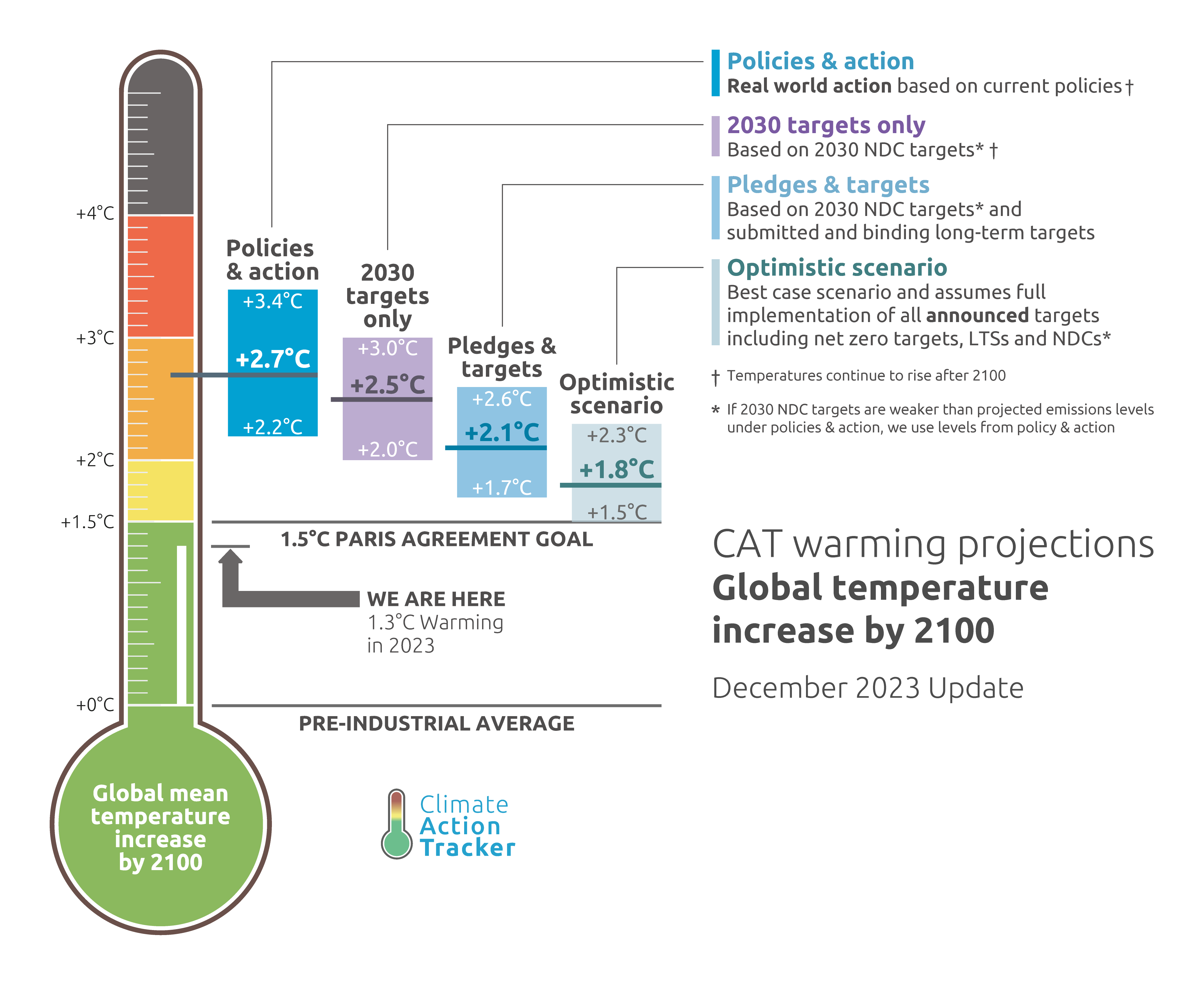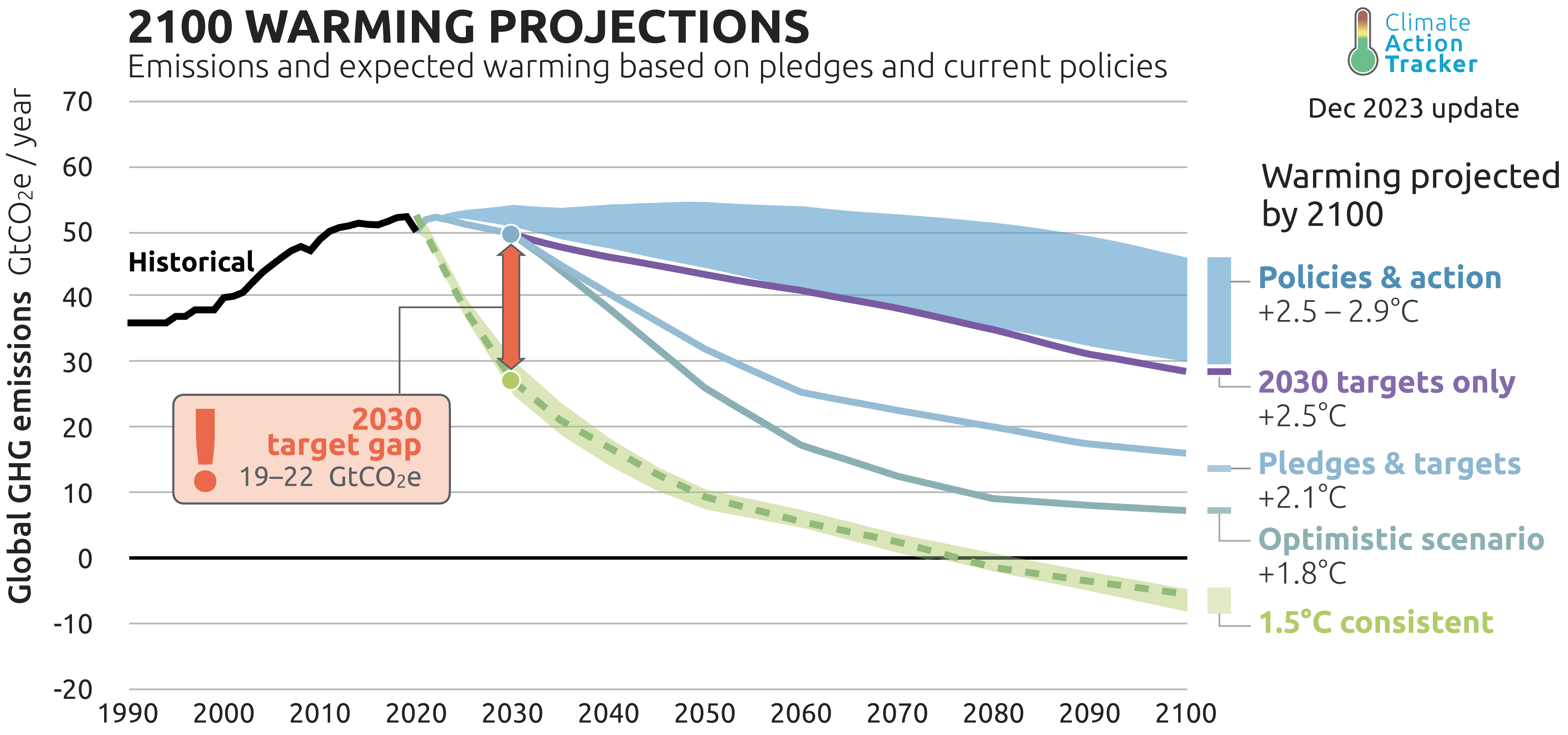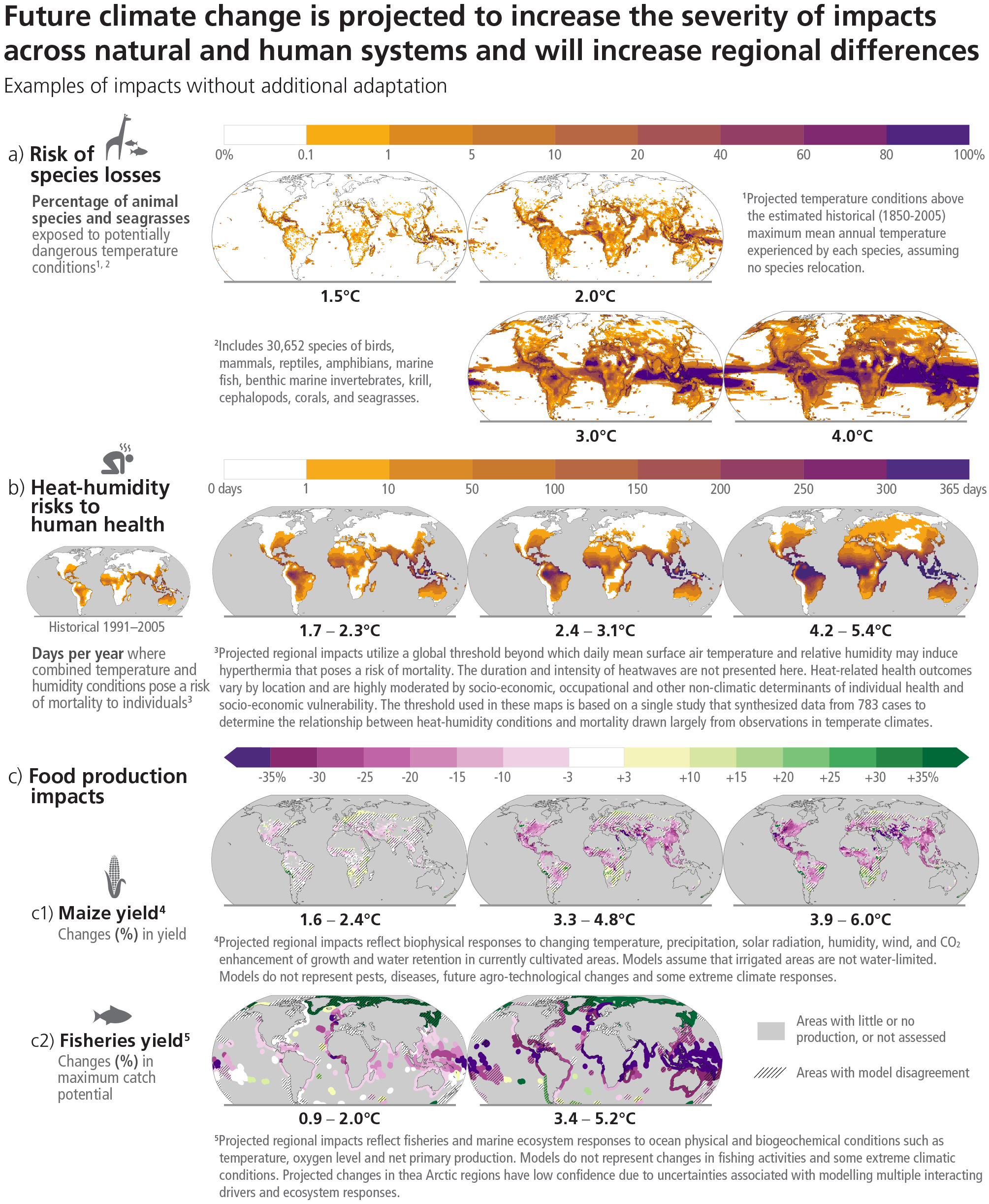1.5. Climate change
Climate change is the other “existential risk” we humans have spurred upon ourselves and on ecosystems. The Holocene has been characterized by very stable climatic conditions that have lasted for nearly 12.000 years. Now, the increasing use of fossil fuels by humans, especially since the 1950s, has increased the amount of carbon dioxide (CO2) in the atmosphere to the effect of increasing the mean global temperature. Without steep and immediate reductions in emissions of carbon dioxide, the warming will continue at a quick pace, with disastrous effects on ecosystems and on human well-being.
Greenhouse effect
The temperature on Earth is determined by the balance of incoming solar radiation and outgoing heat radiation. To put it simply, when there is more energy coming in than going out, the global temperature increases. And when there is more energy going out than coming in, the temperature decreases.
The amount of incoming energy depends on the position of Earth with respect to the Sun, and the amount of outgoing energy depends on the concentration of so-called greenhouse gases in the atmosphere. We will return to them shortly.
The amount of incoming energy fluctuates due to variations in Earth's orbit around the Sun. The orbit is not perfectly circular but fluctuates from almost circular to slightly elliptic in an approximately 100.000-year cycle. This variation is due to the gravitational pull of Saturn and Jupiter. Also, the tilt of Earth's axis fluctuates by a few degrees in a cycle of approximately 41.000 years, and this has an effect on the amount of sunlight falling on the high northern and southern latitudes. The axis also wobbles slightly upon itself, due to the gravitational pull of the Sun and the Moon. The onset and end of previous glaciations in the Quaternary are due to changes in the incoming solar radiation caused by the above-mentioned fluctuations. You can study this further on this NASA web page.
The ongoing climate change however is NOT caused by changes in the amount of energy coming from the Sun.
Instead, the current warming is caused by a reduction in the amount of energy leaving the Earth. And this reduction is due to the increased concentration of so-called greenhouse gases in the atmosphere . Here is how it works.
Greenhouse gases let sunlight pass uninterrupted to the Earth’s surface. When sunlight hits the surface of the Earth, it warms the ground and waters. The Earth also radiates energy, but at much longer wavelengths than the Sun (this is because the wavelength of radiation depends on the temperature of the radiating object, and the Earth is much cooler than the Sun). Greenhouse gases – due to their physical properties stemming from having three or more atoms per molecule – absorb this longer wavelength radiation. The energy of Earth's radiation thus stays in the atmosphere and warms it, instead of escaping to space. This phenomenon is known as the greenhouse effect.
The most important greenhouse gases are carbon dioxide (CO2) and water vapor (H2O), which together are responsible for about 90% of the greenhouse effect. Other greenhouse gases include methane (CH4), nitrous oxide (N2O), and ozone (O3). It is good to realize that water vapor is not driving the increasing temperatures, but it rather amplifies the effects of the other greenhouse gases. This is because the concentration of water vapor is mainly determined by temperature, being higher at high temperatures and lower at low temperatures.
The higher the concentration of greenhouse gases in the atmosphere, the higher is the global mean temperature. If it was not for the warming effect of greenhouse gases, the mean global temperature would be approximately 30 °C degrees lower than today, meaning that there would hardly be liquid water – or life – on the planet.
The fact that burning coal and other fossil fuels will result in an increasing concentration of carbon dioxide, and a consequent increase in global temperature, has been known since the turn of the 20th century. In 1901, Nils Ekholm, a Swedish scientist, published a study titled “On the Variations of the Climate of the Geological and Historical Past and Their Causes”, where he spelled out the physics of climate fluctuation, and those ideas are still valid. Ekholm further wrote that the continued burning of fossil fuels “... will undoubtedly cause a very obvious rise of the mean temperature of the Earth”. What is interesting from today’s perspective is that Ekholm saw controlled emissions of carbon dioxide as a possibility for humans to prevent the onset of the next glacial period.
As we now know, Ekholm had it right: the emissions of greenhouse gases, due mainly to the burning of fossil fuels and the clearing of forests, has indeed resulted in a break from the regular cycles of glacials and interglacials that have been going on for the past 2.5 million years. We are not heading into another glacial period with cold temperatures, extensive ice sheets, and falling sea levels. But contrary to Ekholm’s vision, this did not come about by controlled, but rather by uncontrolled emissions of carbon dioxide.
Since the days of Ekholm at the turn of the 20th century, the atmospheric CO2 concentration has risen steeply, from 295 parts per million (ppm) to 410 ppm in 2019. What is astounding is that the concentration is now way higher than anything recorded over the past 800.000 years (see Figure below). In fact, the last time CO2 levels were as high as today was three million years ago, in the Pliocene, when the mean global temperature was 2-3 degrees warmer than today and sea levels were some 25 meters higher. Concentrations of other greenhouse gases: methane (CH4) and nitrous oxide (N2O) have also risen dramatically as a consequence of expanding agriculture and leakages from oil and gas extraction.
Figure. Atmospheric CO2 concentration over the past 800.000 years
What also makes carbon dioxide so important is that it stays in the atmosphere for hundreds of years. This means that past emissions will continue to warm the climate to the end of this century and beyond. In 2023, human-caused emissions have elevated global mean temperature approximately 1.45 °C from pre-industrial times.
It is already certain that the mean global temperature will continue to increase at least for the coming few decades, but how much, depends on the current and future emissions of greenhouse gases, especially CO2 from the burning of fossil fuels. With strong reductions in greenhouse gas emissions, the increase may be limited to approximately 2 °C. Limiting warming to 1.5 °C would require both steep reductions in emissions and removal of carbon dioxide from the atmosphere.
The technologies for removing carbon dioxide have not been tested in practice. The plans to use massive amounts of biomass for the generation of energy and capturing and storing the produced carbon dioxide (Bioenergy with Carbon Capture and Storage, BECCS) would require vast expanses of land reserved solely for the production of energy biomass. This would certainly have very harmful impacts on nature and human well-being, as it could only be done by either utilizing land currently used for food production, or by transforming natural ecosystems into energy plantations.
The following graph shows the projected average temperatures in 2100 under different emission scenarios. The current policies & actions in place are estimated to lead to a 2.7°C increase in average temperatures. If the national pledges ("2030 targets only" and "Pledges & Targets") made under the Paris Climate Agreement (more on these later in the course) are implemented, a temperature increase of between 2.1 and 2.5 degrees Celsius is projected. Many countries have also discussed more stringent limits ("Optimistic scenario") and if implemented, warming is projected to remain at 1.8 degrees Celsius.

Figure. Projected climate warming in 2100 with different emission policies (source).
The enormity of the challenge with climate change mitigation is clearer when we look at the history of energy consumption and the sources of energy. In the figure below you see how energy consumption has increased dramatically since 1950, and that the increase has been mainly from coal, oil, and gas. The proportion of non-fossil energy sources (e.g. hydropower, wind, and solar) is growing very slowly in comparison to fossil energy sources. The scope for increasing hydropower is also limited, since most rivers in inhabited areas are already harnessed, and building dams to the last-free-running rivers would cause substantial ecological damage.
Figure. Global primary energy consumption by source.
The graph below shows the emission reductions required for different target temperatures. Current emission reductions are nowhere near the scale needed, as the 1.5°C target in the Paris Agreement would require a 40% reduction in emissions by 2030. So far, emissions have increased every year (except 2020 due to the pandemic). Note that the 1.5°C target would also need to be accompanied by strongly negative greenhouse gas emissions towards the end of the century, which means that getting to zero emissions is not enough - large amounts of carbon dioxide would also need to be actively removed from the atmosphere. As already mentioned, there are major technical and other risks associated with the removal of carbon dioxide, and no realistic climate policy can possibly be based on them.

Figure. Greenhouse gas emissions required by climate treaties and projected by policy actions, and the resulting projected average temperature in 2100 relative to pre-industrial times. With current measures, the climate will warm by almost three degrees by 2100 (Source)
To meet our climate targets, we should therefore rapidly move away from fossil fuels and towards renewable energy sources. However, achieving these targets will also require a substantial reduction in energy consumption, because - as we have seen above - the transition to renewables has been very slow.
It is worth noting that energy use and CO2 emissions are extremely unevenly distributed around the world. Lucas Chansel analysed greenhouse gas emissions by country and income class from 1990 to 2019. Over this period, differences between countries have decreased and differences between income classes have increased: in 2019, the richest 10% of the world's population was responsible for 48% of greenhouse gas emissions and the poorest 50% for 11.5% of emissions. However, it is notable that more than 70% of the carbon footprint of the wealthiest was due to investments by rich households, not direct consumption. For the poorest 50%, investments accounted for around 7% of their carbon footprint. According to Chansel, a tax on high carbon footprints in particular would be an effective way to reduce greenhouse gases without making the living conditions of poorer income groups more difficult.
Effects of warming
It is therefore clear that anthropogenic greenhouse gas emissions have already changed the global climate, and warming will continue for at least the next few decades. What are the impacts of climate change on nature and people? What is the difference between limiting warming to less than 2°C and 3°C? What if emissions are not limited at all and the climate warms by four degrees?
The 2023 report of the UN Intergovernmental Panel on Climate Change (IPCC) concludes that the effects of anthropogenic global warming are already clearly visible.
- Sea levels have risen by 20 cm since the beginning of the 20th century. The rate of rise has accelerated and is now around 4 mm per year.
- The impact of warming is also reflected in the increase in the frequency and/or intensity of extreme weather events such as heat waves, heavy rainfall, droughts and storms. Extreme weather events such as exceptional drought and heat are increasingly occurring simultaneously.
- Climate change has been found to be associated with heat-related deaths and health problems, as well as water, food and insect-borne diseases.
- Climate change-related phenomena have led to increased migration on several continents, particularly in small tropical island states.
- Climate change-related phenomena have caused problems for agriculture, fisheries and aquaculture, and have damaged and destroyed settlements and other infrastructure.
- The most vulnerable people are particularly affected. More than three billion people live in conditions where the risks posed by climate change are particularly acute, affecting inter alia food security and access to water.
- Climate change has damaged numerous ecosystems around the world and caused the local extinction of hundreds of species. Extreme temperature events have led to a number of mass extinctions of organisms. Fragile ecosystems, including those in mountain ranges and the Arctic, are being irreversibly altered.
- According to a 2024 study by Cunningham and partners, high-energy wildfires and forest fires have become more frequent and intensified markedly in the 2000s. Global warming-induced forest drying has increased the intensity of fires, particularly in temperate and northern coniferous forests.
Global warming will continue in the coming decades in almost all IPCC emission scenarios and modelling. At the same time, climate change phenomena will intensify the less we succeed in limiting greenhouse gas emissions.The following figure from the IPCC report shows how different degrees of global warming will affect species loss, human health and food production around the world.

“Reasons for concern”
The Intergovernmental Panel on Climate Change (IPCC) has identified five “Reasons for Concern” that illustrate the impacts and risks of different levels of global warming for people, economies, and ecosystems across sectors and regions.
1. Unique and threatened systems: ecological and human systems that have restricted geographic ranges constrained by climate-related conditions and have high endemism or other distinctive properties. Examples include coral reefs, the Arctic and its indigenous people, mountain glaciers, and biodiversity hotspots.
Some ecosystems and cultures are already at risk from climate change, and the number of unique and threatened systems at risk increases with further warming. The risks are very high for many systems with limited adaptive capacity, particularly those associated with Arctic sea ice and coral reefs, already with 1.5°C warming. In addition to risks resulting from the magnitude of warming, terrestrial species are also sensitive to the rate of warming due to the limited capability of biomes and species to track the shifting conditions, marine species to the rate and degree of ocean acidification, and coastal systems to sea-level rise.
2. Extreme weather events: risks/impacts to human health, livelihoods, assets, and ecosystems from extreme weather events such as heatwaves, heavy rain, drought, and associated wildfires, and coastal flooding.
The risks associated with extreme weather events have already begun to materialise, and are extremely high as warming reaches 2 degrees Celsius. The further climate change progresses, the bigger the risks and damage from extreme weather events will also be. The ability of human communities to prepare for and adapt to extreme weather events will influence the magnitude of the risks: in areas where infrastructure is weak, the risks will be greatest.
3. Distribution of impacts: risks/impacts that disproportionately affect particular groups due to uneven distribution of physical climate change hazards, exposure, or vulnerability.
The risks from climate change are generally greater for disadvantaged people and communities everywhere. Risks are already moderate because of regional differences in observed climate change impacts, particularly for crop production. Based on regionally differentiated risks to food security, water resources, drought, heat exposure, and coastal submergence, risks of unevenly distributed impacts are elevated already with less than 2°C of global warming.
4. Global aggregate impacts: global monetary damage, global-scale degradation, and loss of ecosystems and biodiversity.
The risk of global economic and ecosystem problems has already risen at 1-2 degrees of warming. Large-scale loss of biodiversity, which in turn leads to a reduction in the regulatory functions of nature and other benefits from nature, will lead to high risks if warming reaches between 1.5 and 2.5 degrees Celsius. Global economic damages will increase as warming continues.
5. Large-scale singular events (also called ‘tipping points’): relatively large, abrupt, and sometimes irreversible changes in systems that are caused by global warming. Examples include disintegration of the Greenland and Antarctic ice sheets, drying of the Amazon rainforest, and thawing of Arctic permafrost.
These changes can set off a chain of events (like falling dominoes) that will accelerate climate change beyond any human control. As average temperatures rise, certain physical and biological systems are at risk of changing abruptly and/or irreversibly.
Already, coral reefs in warm waters and Arctic ecosystems are showing signs of fundamental and irreversible change. The risks increase very rapidly with global warming and are high when warming exceeds 2 degrees Celsius - in particular due to possible sea-level rise as glaciers are lost.
If global warming remains between 1.5 and 4 °C, the Greenland ice sheet will melt in the course of just over a thousand years, which would raise sea levels by seven metres. As climate change progresses, living conditions will become intolerable for an increasing number of people, who will have to move elsewhere. Migration is dangerous for many reasons, including vulnerability to extreme weather events, especially in countries with weak social structures and infrastructure. Climate change can also increase violent conflicts by increasing migration, poverty and economic crises.
Even if global average temperatures stabilise, many systems will continue to change. Changing vegetation zones, soil carbon stocks, ice sheets, ocean temperatures and water levels are all changing slowly and over long periods of time, and will continue to do so for hundreds or thousands of years after the average global temperature has stabilised.
More material online
You can learn more about the role of climate change in extreme weather events here: https://www.worldweatherattribution.org/
For reflection: what is your perception of the possibilities for mitigating climate change? What are your views on how to best mitigate climate change? You can share your reflections and discuss with other course participants on the page linked below.
Would you like to comment something on this section? Voluntary.
